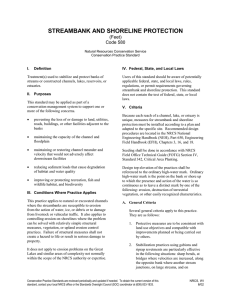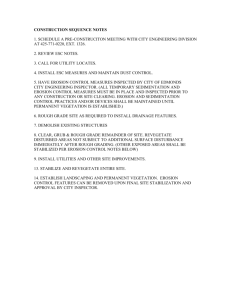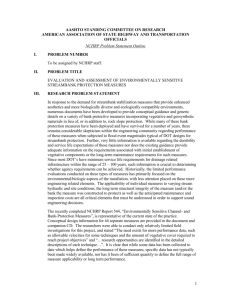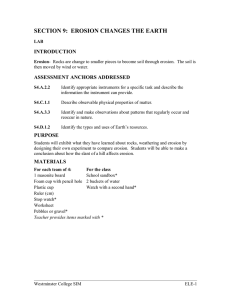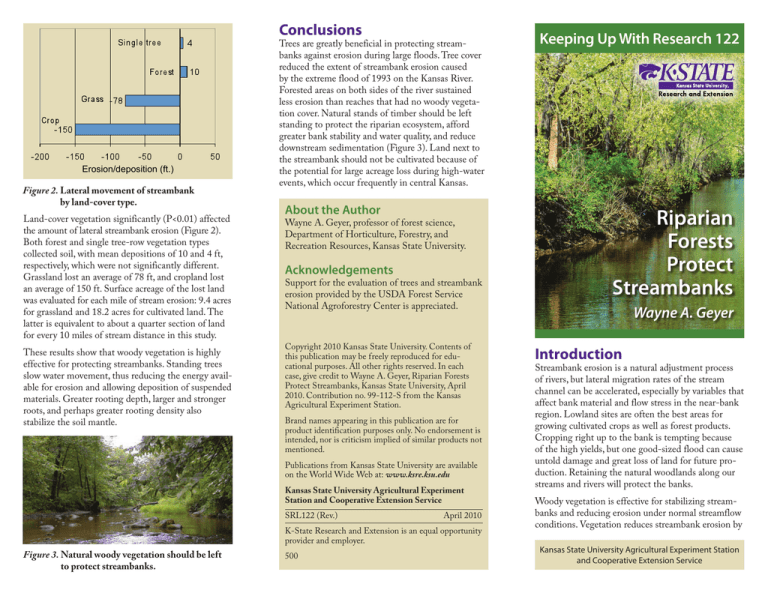
Conclusions
Erosion/deposition (ft.)
Figure 2. Lateral movement of streambank
by land-cover type.
Land-cover vegetation significantly (P<0.01) affected
the amount of lateral streambank erosion (Figure 2).
Both forest and single tree-row vegetation types
collected soil, with mean depositions of 10 and 4 ft,
respectively, which were not significantly different.
Grassland lost an average of 78 ft, and cropland lost
an average of 150 ft. Surface acreage of the lost land
was evaluated for each mile of stream erosion: 9.4 acres
for grassland and 18.2 acres for cultivated land. The
latter is equivalent to about a quarter section of land
for every 10 miles of stream distance in this study.
These results show that woody vegetation is highly
effective for protecting streambanks. Standing trees
slow water movement, thus reducing the energy available for erosion and allowing deposition of suspended
materials. Greater rooting depth, larger and stronger
roots, and perhaps greater rooting density also
stabilize the soil mantle.
Trees are greatly beneficial in protecting streambanks against erosion during large floods. Tree cover
reduced the extent of streambank erosion caused
by the extreme flood of 1993 on the Kansas River.
Forested areas on both sides of the river sustained
less erosion than reaches that had no woody vegetation cover. Natural stands of timber should be left
standing to protect the riparian ecosystem, afford
greater bank stability and water quality, and reduce
downstream sedimentation (Figure 3). Land next to
the streambank should not be cultivated because of
the potential for large acreage loss during high-water
events, which occur frequently in central Kansas.
About the Author
Wayne A. Geyer, professor of forest science,
Department of Horticulture, Forestry, and
Recreation Resources, Kansas State University.
Acknowledgements
Support for the evaluation of trees and streambank
erosion provided by the USDA Forest Service
National Agroforestry Center is appreciated.
Copyright 2010 Kansas State University. Contents of
this publication may be freely reproduced for educational purposes. All other rights reserved. In each
case, give credit to Wayne A. Geyer, Riparian Forests
Protect Streambanks, Kansas State University, April
2010. Contribution no. 99-112-S from the Kansas
Agricultural Experiment Station.
Brand names appearing in this publication are for
product identification purposes only. No endorsement is
intended, nor is criticism implied of similar products not
mentioned.
Publications from Kansas State University are available
on the World Wide Web at: www.ksre.ksu.edu
Kansas State University Agricultural Experiment
Station and Cooperative Extension Service
SRL122 (Rev.)
Figure 3. Natural woody vegetation should be left
to protect streambanks.
April 2010
K-State Research and Extension is an equal opportunity
provider and employer.
500
Keeping Up With Research 122
Riparian
Forests
Protect
Streambanks
Wayne A. Geyer
Introduction
Streambank erosion is a natural adjustment process
of rivers, but lateral migration rates of the stream
channel can be accelerated, especially by variables that
affect bank material and flow stress in the near-bank
region. Lowland sites are often the best areas for
growing cultivated crops as well as forest products.
Cropping right up to the bank is tempting because
of the high yields, but one good-sized flood can cause
untold damage and great loss of land for future production. Retaining the natural woodlands along our
streams and rivers will protect the banks.
Woody vegetation is effective for stabilizing streambanks and reducing erosion under normal streamflow
conditions. Vegetation reduces streambank erosion by
Kansas State University Agricultural Experiment Station
and Cooperative Extension Service
images, such as roads, railroad tracks, and mile section
lines, were digitized from the quadrangle maps.
Once the base maps were digitized, streambank edges
from the 1992 and 1993 slide images of the Kansas
River were digitized. Notes regarding land-cover
condition were made within the drawing as needed.
Then a river centerline was interpolated within
the CAD drawing by using the 1992 streambanks
as a guide. The centerline served as a reference
for river position and demarcation and land-cover
classification.
Figure 1. Historical mean discharge of the Kansas River at the beginning point of the study area (Wamego, Kan.).
slowing streamflow velocity, trapping sediments in
its stems and foliage, and binding soil.
Streambank channel erosion varies with channel
position. Extensive erosion typically occurs at the
outside bend, where flow velocities are greatest,
whereas soil particles deposit and form sandbars
at the inside bends, where velocities are slowest.
Variation of stream discharge appears to occur in
about 15- to 20-year cycles. The flood of 1993
(500 year) was of historic proportions, but a similar flow occurred in the early 1950s. Streamflow in
central Kansas in 1950 and 1993 was 4.5 times the
historical yearly averages (Figure 1). Because of this
variation, streambank losses usually are not recognized until a major high-water event happens.
Erodibility depends on bank height, the ratio of
root depth to bank height, bank angle, and surface
protection. High, steep banks, steep undercut banks,
low root density, highly stratified soil, and fine soil
particle size all increase erosion potential.
Studies conducted in the Midwestern United States
have shown that erosion from wooded areas, grasses,
corn, and fallow land is 0.00, 0.04, 73.2, and 69 tons/
acre, respectively.
This study was undertaken to evaluate the influence
of natural woodland vegetation on lateral streambank
erosion/deposition following the 1993 flood.
Procedures
Study Area
The study area was in the Kansas River Basin, which
covers about 60,000 square miles in three states. The
specific zone of study was a 40-mile portion near
Manhattan, Kan. The woody vegetation along the
river consists of many tree species including cottonwood (Populus deltoides), silver maple (Acer saccharinum), willow species (Salix spp.), hackberry (Celtis
occidentalis), sycamore (Platanus occidentalis), and elm
species (Ulmus spp.).
Tools of Investigation
Local offices of the Consolidated Farm Service
Agency provided slide images of the study area
taken in December 1992 and December 1993. These
aerial images were used to compare easily identified
features, such as riparian vegetation and streambank
edge, of pre- and post-flood streambanks.
Data Collection Process
Photocopies of the slides were transferred with a
CalCompl digitizing tablet into a LandCADDI R12
computer-aided drawing (CAD) program file. The
photocopies were calibrated to previously digitized
U.S. Geological Survey 7.5-min topographical quadrangle maps to enable accurate scaling and analysis of
the images. Only features useful in calibrating slide
Data collection points were established at regular
500-ft intervals along the centerline in the study area.
At these points, land cover was classified by using the
1992 aerial photographs as references. Erosion and
deposition amounts were estimated by measuring the
perpendicular distance from the 1992 streambank to
the 1993 streambank at data collection points.
Land-cover vegetative types in the 100-ft zone next
to the 1992 streambank were categorized as forest
land, cropland, grassland, or single tree-row. A forested streambank is one on which the dominant landcover type (>51%) is woody vegetation. A cropland or
grassland streambank is one on which the dominant
land-cover type is agricultural crops or grass, respectively. A single tree-row streambank has a single row
of trees adjacent to a non-forest land-cover type.
Vegetation data were collected for both the left- and
right-side streambanks at every data collection point
and inserted into the CAD program. Data from both
sides of the river were pooled.
Results and Discussion
Data were collected from 204 streambank points
(103 right side and 101 left side). These data points
were classified as follows: 96 points as forest land,
37 as cropland, 47 as grassland, and 24 as single
tree-row. Thus, 59% of the banks were tree lined.
About 62% of the banks had sandy soils, and 38%
had loamy soils. The streams generally were of two
types, meandering (63%) and relatively shallow
and braided (37%). Many of the streambanks were
entrenched.


